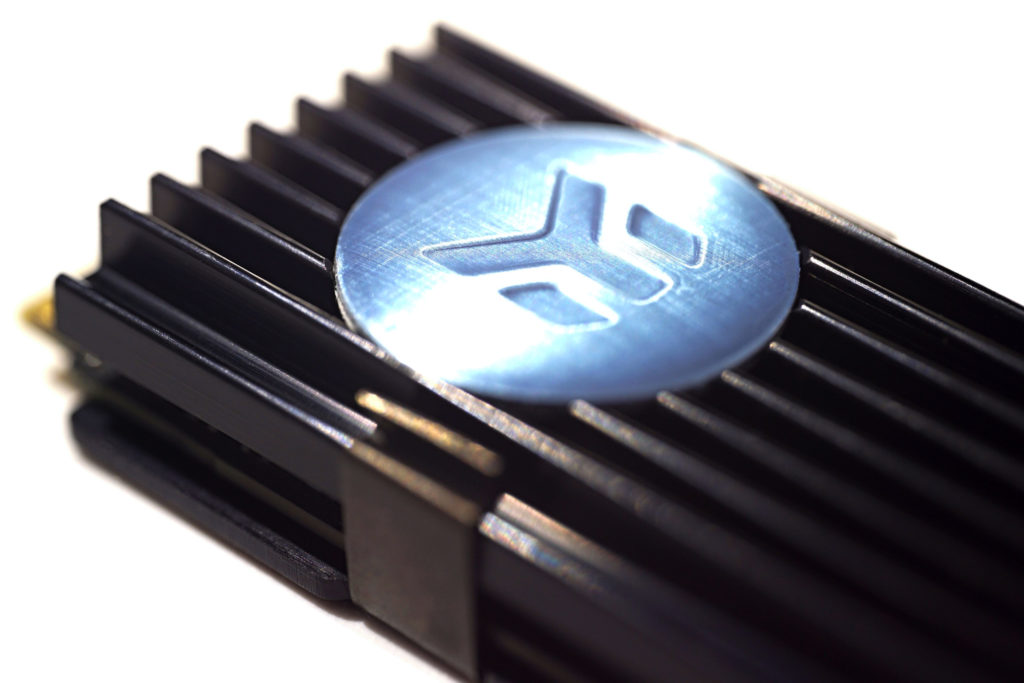EKWB EK-M.2 in an advanced era
You may remember our old tests of SSD coolers, which were topped by the EKWB EK-M.2. The latter was something of a minor miracle five years ago, beside the various unfinished solutions. Given that its production is still ongoing, it’s interesting to see how the once cutting-edge SSD cooler stands up against the current competition. That’s why we dusted it off (a new piece with fresh pads, of course) and sent it into battle.
<retrospective_window>The history of M.2 SSD coolers is relatively short, much like the existence of SSDs themselves in this format. We well remember an email in which an MSI representative, after returning the X370 Gaming Pro Carbon board, asked us additionally for the “M.2 shield” that was left stuck on the testing SSD. This thin slice can be described as one of the first SSD coolers and the first cooler (hopefully not wrong…) that was part of the motherboard accessories. EKWB EK-M.2.<retrospective_window/>
Compared to competing models to the tune of the Alphacool HDX M.2 or the Adata XPG Storm the EKWB cooler performed significantly better. It probably wasn’t the first cooler with a reasonably articulated surface, but given the distribution (and good availability) there weren’t many other efficient SSD coolers like the EK-M.2. While that’s no longer the case, there really are a lot of those options, design-wise the EKWB cooler is still competitive.
The profile of the EK-M.2 is similar to the Axagon CLR-M2L3 with the same number (8) of fins, which the EKWB cooler has a bit taller and at the same time thinner. In both cases, however, they are aluminum monoliths with similar weight (14 g) and surface area, so the potentials of the heatsinks will not be too far apart.
The heat transfer from the SSD to the heatsink is also influenced by the characteristics of the thermal pads or mounting system. The EK-M.2 is a significantly more expensive cooler and, unlike the Axagon CLR-M2L3, uses a backplate that attaches to the side fins of the heatsink via metal clips. Unlike the often used “U” profile designs, the EKWB’s backplate is flat and due to it being “only” a millimeter thick, it bends a bit under more pressure. However, with the small forces that are applied to it in practice (either from the actual mounting system via the clips or from mounting on the motherboard), there should be no major deformations that would impair contact.
In cooling of the controller, the EKWB EK-M.2 lags behind the Axagon CLR-M2L3 only a little bit, in our conditions (see the end of this chapter for the testing methodology) by 3 °C, in memory cooling by 7 °C. Yet the EKWB EK-M.2 costs at least three times as much (15 EUR). Coolers for similar money, which includethe BeQuiet! MC1 Pro, cool SSDs significantly more effectively, by at least 10 °C. When aligned by similar height, the cheaper BeQuiet! – MC1 and also the Gelid IceCap, which is, admittedly, already 2 mm taller, are better off, but they still don’t affect the compatibility with the surrounding components.
It can be stated that the competing designs already mostly outperform the EKWB EK-M.2, which is natural, since they came out much later. But if you have this EKWB cooler on your SSD, you can stay calm, it’s still decent and enough for the needs of even the most powerful PCIe 4.0 SSDs.
Methodology
The tests take place in a wind tunnel that replaces a standard computer case. Four Noctua NF-S12A PWM@550 rpm fans are used for system cooling in a balanced ratio of two intake to two exhaust fans. The intake air temperature is strictly controlled and is kept within a narrow range of 21–21.3 °C for maximum accuracy.
In line with findings from measurements of the impact of different positions on cooling efficiency, we test separate SSD coolers in the first slot, above the graphics card. From board tests we naturally have a lot of results of coolers (referred to as cooler 1 and cooler 2) from other positions as well, but there it is due to their fixed position.
For testing, we use the Samsung 980 Pro SSD (1TB). The load is run for 10 minutes (which is enough time in the wind tunnel for temperatures to stabilize) in CrystalDiskMark – sequential read and write cycles. The achieved power draw then is about 8 W, which is the upper limit of what M.2 SSDs achieve and shouldn’t change even models with PCIe 5.0 interface support.
English translation and edit by Jozef Dudáš
Možno si spomeniete na naše staré testy chladičov SSD, ktoré víťazne uzatváral model EKWB EK-M.2. Ten bol pred piatimi rokmi popri rôznych nedotiahnutých riešeniach ako zjavenie. Vzhľadom na to, že jeho výroba stále prebieha je zaujímavé sledovať, ako kedysi špičkový chladič SSD stojí v porovnaní so súčasnou konkurenciou. Preto sme ho oprášili (samozrejme nový kus s čerstvými vložkami) a poslali do boja.
Results: SSD temperature
